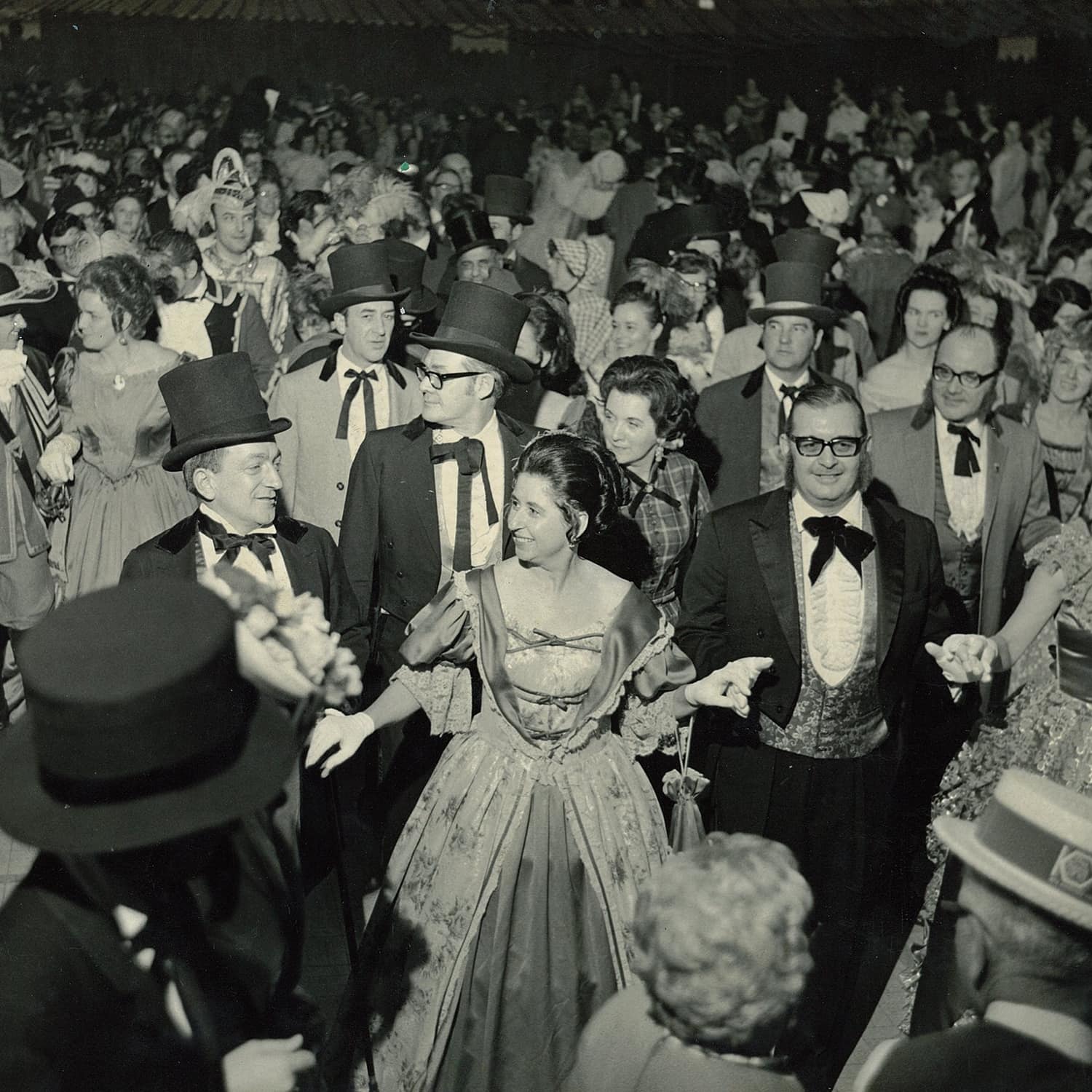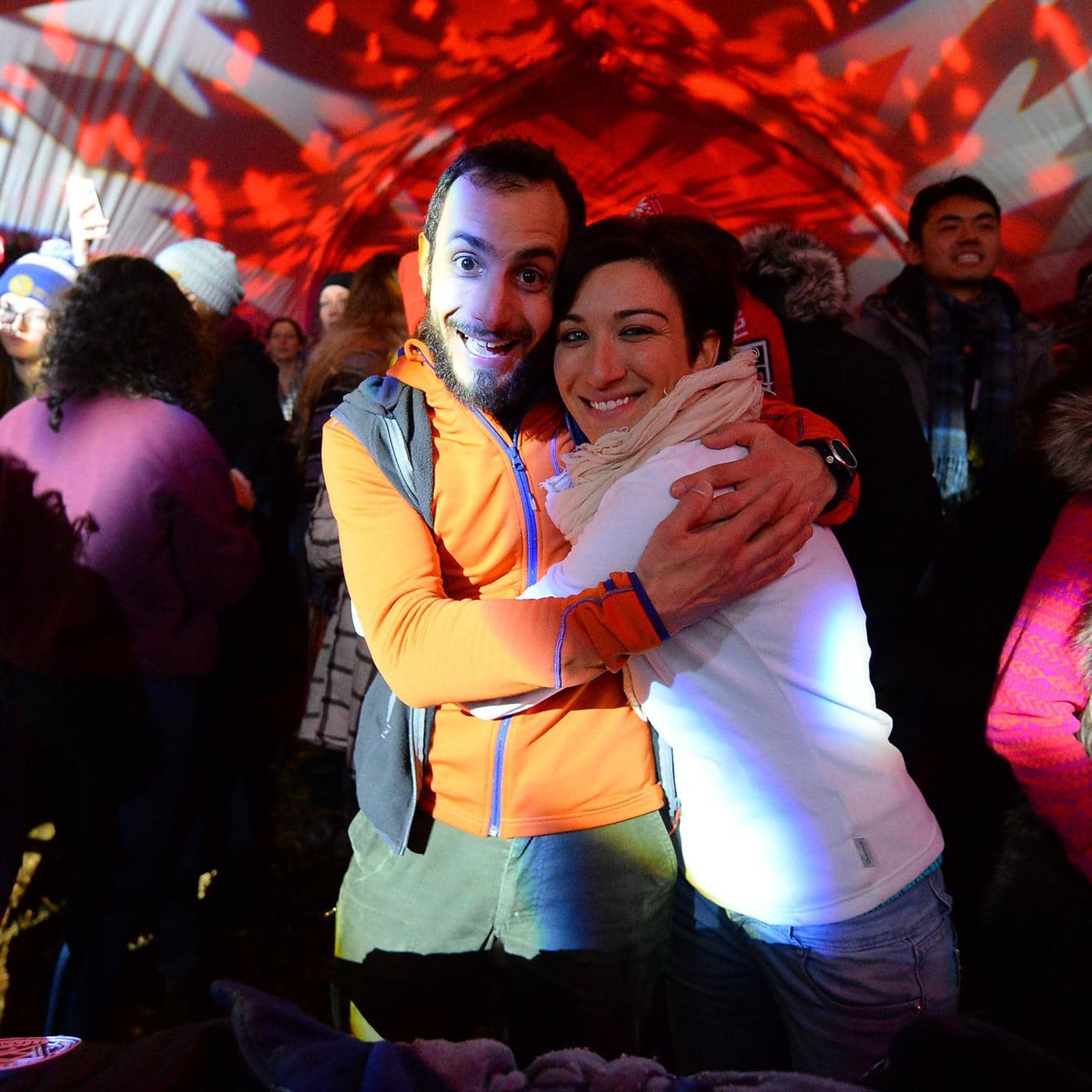Our History
Proudly rooted in our community
THE BEGINNINGS

The concept of a winter festival celebrating Manitoba’s Francophonie took root in 1967 among a few brave citizens of Saint-Boniface who organized themselves under the banner of the Saint-Boniface Chamber of Commerce. They approached the City of Winnipeg with a plan in the hopes of obtaining some financial backing. Unfortunately, the offer the city put forth could not sustain such an ambitious idea. They would have to wait.
The following year, the organizers approached the city with the support of 18 different community organizations. The City of Saint-Boniface gave the plan its full approval and the very first Festival du Voyageur took place in 1970, within the context of the official celebrations of Manitoba’s centenary. Georges Forest was given the task of promoting the event. To do so, he decided to wear clothing based on the image of the voyageur, becoming the first Official Voyageur and creating a tradition that continues to this day. The celebrations lasted four days and introduced people to some of the festival’s most popular events, including the walk down Provencher Boulevard, the Governor’s Bal and the Voyageur Trading Post.
One year later, a sculpture of a toque and boots took first place in the snow sculpting contest and inspired the image of Léo La Tuque, who became in 1972 the official mascot and trademark of Festival du Voyageur.
Year after year, Festival du Voyageur continued to grow in popularity and it became obvious that the festival’s location, Provencher Park, was now too small to accommodate the influx of festival-goers. The organization decided it was time to start a project that would change the festival forever; they would move the festivities to Whittier Park.
In 1977, construction began on a wooden log cabin in Whittier Park. It was the very first building to appear on the site where Fort Gibraltar would eventually be erected. The festival would take place in Whittier Park from then on and would continue to attract more and more visitors.
The Rendez-Vous days

In 1981, Festival du Voyageur decided to purchase an empty warehouse, located at 768 Taché Avenue. The organizers wanted a place that could house the administrative offices and become a venue for some important festival activities and concerts. The building, better known as the Rendez-Vous, hosted many functions, including banquets, dances, shows, meetings, concerts, exhibitions and television programmes. The Rendez-Vous also housed a bar named Le Canot, a hotspot among Festival du Voyageur members and Franco-Manitobans.
The organization flourished in its new offices and saw an increase in full-time permanent employees. Finally, after years of uncertainty, the company was experiencing some organizational and financial stability.
By the end of the 1990s, members of the organization decided they were ready to undertake a new project; to build a big house in the heart of Fort Gibraltar where would take place a host of events throughout the year. Thanks to some financial backing from private contributors as well as from the provincial and federal governments, construction was able to begin in February of 2001. The Maison du Bourgeois officially opened its doors in October of 2001.
Following a particularly tough financial year in 2003, the organizers decided it was in the company’s best interest to sell the Rendez-Vous, in order to give Festival du Voyageur some financial leeway.
Today's festival

After waiting a few years, the Rendez-Vous eventually found a buyer and was sold in 2006. The sale also included Festival du Voyageur’s administrative offices, which meant the organization had to find a new locale. The administrators found a perfect building and the company moved into its new digs at 233 Provencher, in the heart of Saint-Boniface. A new store was installed in the new office called the Boutique du voyageur, where members of the public can purchase Festival du Voyageur merchandise throughout the year.
In 2005, Festival du Voyageur decided it was time to maximize the use of the historical facilities at Fort Gibraltar. The organizers chose to establish a historical interpretation centre and to have it open to the public during the summer months. Today, a school programme and a public programme are offered at Fort Gibraltar from May to September, five days a week. In all, six costumed interpreters work all summer to bring the fascinating histories of the voyageurs and the fur trade era back to life.
The company continues to solidify its financial situation thanks, in no small part, to consistently well organized and well attended festivals. Today, Festival du Voyageur is in very good hands and employs 13 full-time permanent staff members who work all year to assure the festival’s continued success.
In 2011, a study revealed that Festival du Voyageur has an economic impact was of $12.9 million, while the company hires more than 200 employees at the festival’s peak. The number of visitors keeps climbing year after year; we welcomed around 97,000 visitors during FDV 2013’s public programme and more than 10,750 students for the Great-West Life School Program.
PART 1 – THE BEGINNINGS:
FROM 1969 TO 768 TACHÉ

The concept of a winter festival celebrating Manitoba’s Francophonie took root in 1967 among a few brave citizens of Saint-Boniface who organized themselves under the banner of the Saint-Boniface Chamber of Commerce. They approached the City of Winnipeg with a plan in the hopes of obtaining some financial backing. Unfortunately, the offer the city put forth could not sustain such an ambitious idea. They would have to wait.
The following year, the organizers approached the city with the support of 18 different community organizations. The City of Saint-Boniface gave the plan its full approval and the very first Festival du Voyageur took place in 1970, within the context of the official celebrations of Manitoba’s centenary. Georges Forest was given the task of promoting the event. To do so, he decided to wear clothing based on the image of the voyageur, becoming the first Official Voyageur and creating a tradition that continues to this day. The celebrations lasted four days and introduced people to some of the festival’s most popular events, including the walk down Provencher Boulevard, the Governor’s Bal and the Voyageur Trading Post.
One year later, a sculpture of a toque and boots took first place in the snow sculpting contest and inspired the image of Léo La Tuque, who became in 1972 the official mascot and trademark of Festival du Voyageur.
Year after year, Festival du Voyageur continued to grow in popularity and it became obvious that the festival’s location, Provencher Park, was now too small to accommodate the influx of festival-goers. The organization decided it was time to start a project that would change the festival forever; they would move the festivities to Whittier Park.
In 1977, construction began on a wooden log cabin in Whittier Park. It was the very first building to appear on the site where Fort Gibraltar would eventually be erected. The festival would take place in Whittier Park from then on and would continue to attract more and more visitors.
PART 2 – THE TACHÉ ERA:

FROM THE PURCHASE TO THE SALE OF THE RENDEZ-VOUS
In 1981, Festival du Voyageur decided to purchase an empty warehouse, located at 768 Taché Avenue. The organizers wanted a place that could house the administrative offices and become a venue for some important festival activities and concerts. The building, better known as the Rendez-Vous, hosted many functions, including banquets, dances, shows, meetings, concerts, exhibitions and television programmes. The Rendez-Vous also housed a bar named Le Canot, a hotspot among Festival du Voyageur members and Franco-Manitobans.
The organization flourished in its new offices and saw an increase in full-time permanent employees. Finally, after years of uncertainty, the company was experiencing some organizational and financial stability.
By the end of the 1990s, members of the organization decided they were ready to undertake a new project; to build a big house in the heart of Fort Gibraltar where would take place a host of events throughout the year. Thanks to some financial backing from private contributors as well as from the provincial and federal governments, construction was able to begin in February of 2001. The Maison du Bourgeois officially opened its doors in October of 2001.
Following a particularly tough financial year in 2003, the organizers decided it was in the company’s best interest to sell the Rendez-Vous, in order to give Festival du Voyageur some financial leeway.

PART 3 – THE PROVENCHER ERA:
Then till now
After waiting a few years, the Rendez-Vous eventually found a buyer and was sold in 2006. The sale also included Festival du Voyageur’s administrative offices, which meant the organization had to find a new locale. The administrators found a perfect building and the company moved into its new digs at 233 Provencher, in the heart of Saint-Boniface. A new store was installed in the new office called the Boutique du voyageur, where members of the public can purchase Festival du Voyageur merchandise throughout the year.
In 2005, Festival du Voyageur decided it was time to maximize the use of the historical facilities at Fort Gibraltar. The organizers chose to establish a historical interpretation centre and to have it open to the public during the summer months. Today, a school programme and a public programme are offered at Fort Gibraltar from May to September, five days a week. In all, six costumed interpreters work all summer to bring the fascinating histories of the voyageurs and the fur trade era back to life.
The company continues to solidify its financial situation thanks, in no small part, to consistently well organized and well attended festivals. Today, Festival du Voyageur is in very good hands and employs 13 full-time permanent staff members who work all year to assure the festival’s continued success.
In 2011, a study revealed that Festival du Voyageur has an economic impact was of $12.9 million, while the company hires more than 200 employees at the festival’s peak. The number of visitors keeps climbing year after year; we welcomed around 97,000 visitors during FDV 2013’s public programme and more than 10,750 students for the Great-West Life School Programme.
Our Organization
Signup for updates
The early days
Gabriel Forest, Georges Forest's brother and Lucienne Loicelle, member of the Order of Official Voyageurs, recount the early days of the festival. Video only available in french with english subtitles.

